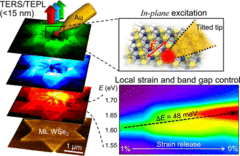Hybrid tip-enhanced nanospectroscopy and nanoimaging of monolayer WSe2 with local strain control
| Reviews and Highlights | Quantum Science | Molecular and Soft-matter | Ultrafast Nano-optics and Nanophotonics | Mineralogy and Geochemistry |
|---|
Kyoung-Duck Park, Omar Khatib, Vasily Kravtsov, Genevieve Clark, Xiaodong Xu, and Markus B. Raschke
Nano Lett. 16, 2621 (2016).
DOI PDF SI

Many classes of two-dimensional (2D) materials have emerged as potential platforms for novel electronic and optical devices. However, their physical properties are strongly influenced by nanoscale heterogeneities in the form of edges, twin boundaries, and nucleation sites. Using combined tip-enhanced Raman scattering and photoluminescence (PL) nanospectroscopy and nanoimaging, we study the associated effects on the excitonic properties in monolayer WSe2 grown by physical vapor deposition. With ∼15 nm spatial resolution, we resolve nanoscale correlations of PL spectral intensity and shifts with crystal edges and internal twin boundaries associated with the expected exciton diffusion length. Through an active atomic force tip interaction we can control the crystal strain on the nanoscale and tune the local bandgap in reversible (up to 24 meV shift) and irreversible (up to 48 meV shift) fashion. This allows us to distinguish the effect of strain from the dominant influence of defects on the PL modification at the different structural heterogeneities. Hybrid nano-optical spectroscopy and imaging with nanomechanical strain control thus enables the systematic study of the coupling of structural and mechanical degrees of freedom to the nanoscale electronic and optical properties in layered 2D materials.
